10 Best Condenser Microphones – The Optimal Way Of Recording Sound
We may also earn commissions on purchases from other retail websites.
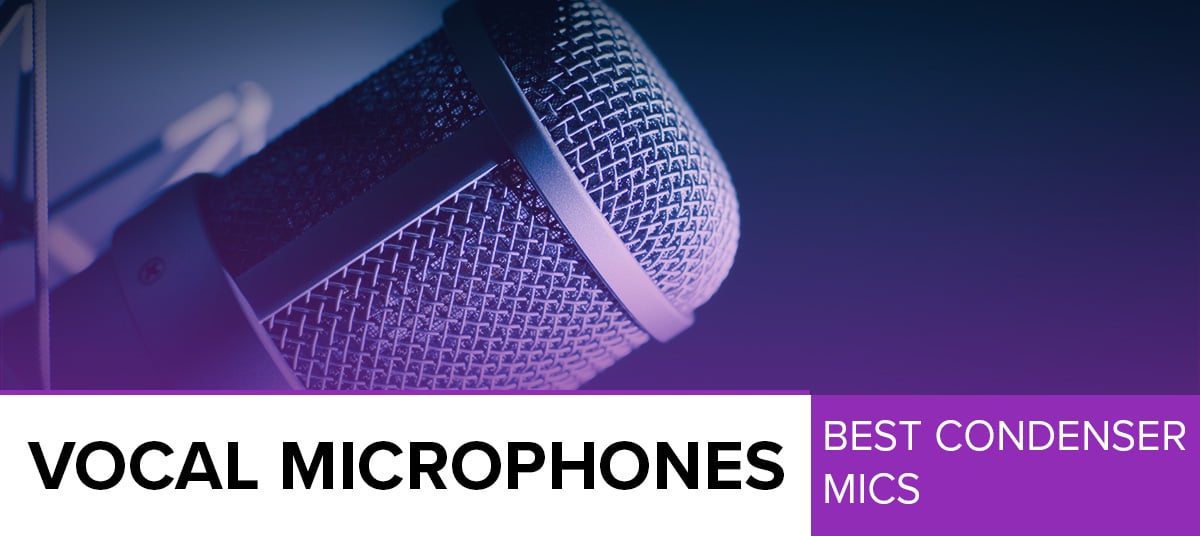
Last Updated: December-04-2018
In our most recent update, we made some big changes to this article on the best condenser mics on the market! As well as some content tweaks, we gave our chart a little shakeup, by replacing some popular mics with… even more popular mics! These additions included two high-end highfliers in the gorgeous MXL V67i Tube and the Sennheiser MK4, while the affordable MXL 770 made a great impression in the lower-end of the market.
While dynamic microphones may be the go-to choice for stage work, when it comes to recording in a studio, a bit more finesse is required. For this, there’s nothing better than a condenser microphone.
In today’s article we are going to look at these important mics more in depth, including what they are, how they vary, and how a good condenser mic can help you record music in a way that yields great results.Before that, we are going to run you through a top ten chart highlighting our favorite condenser mics on sale today – from budget models to high-end microphones. By the time you are done reading this guide, you should have all the info you need to make an educated decision! Let’s get started.
Top 10 Condenser Microphones
| Image | Microphones / Rating | Summary | Check Price |
|---|---|---|---|
+ -  | Avantone Pro CV-12 Total of 4.92/5 | One of the most authentic tube microphones you can get right now. | |
+ -  | Aston Microphones Spirit Total of 4.78/5 | An unusual but ultimately impressive condenser mic offering plenty of great performance. | |
+ - 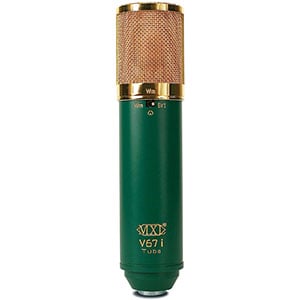 | MXL V67i Tube Total of 4.72/5 | Vintage tube tone and retro looks in a modern high-end mic. | |
+ - 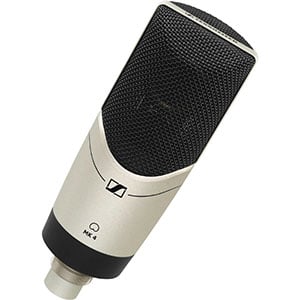 | Sennheiser MK4 Total of 4.73/5 | Hard to fault this no frills German-made condenser. | |
+ -  | Shure SM-27 Total of 4.55/5 | Easily one of the most reliable all purpose condenser microphones currently available. | |
+ -  | AKG P420 Total of 4.28/5 | A workhorse that brings clarity and versatility at a really great price. | |
+ -  | Audio-Technica AT2035 Total of 4.22/5 | A worthy successor of a legendary microphone that packs even more versatility. | |
+ -  | Behringer B-1 Total of 4.13/5 | Extremely versatile and capable option that is great for elaborate studio builds. | |
+ -  | Audio-Technica AT2020 Total of 4.05/5 | A very solid performer that defines the budget segment of the market | |
+ - 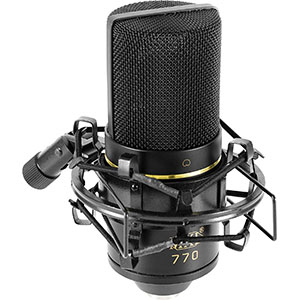 | MXL 770 Total of 4.65/5 | An elegant condenser mic with a sensational performance. |
Avantone Pro CV-12
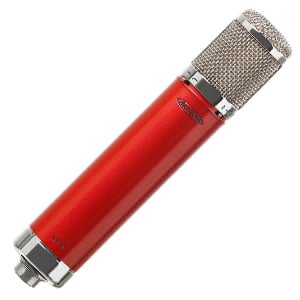
| Design: |  |
| Features: |  |
| Performance: |  |
| Value: |  |
Topping this mega condenser mic chart is the exceptional CV-12 from the New York-based brand Avantone Pro. This brand has a reputation for making stunning mics with great attention-to-detail, and the CV-12 really upholds this.
With a slim red chassis, chrome detailing and a rock-solid build, the feeling of quality is instantly apparent. But the sound quality – as we highlight in the complete CV-12 review – is exceptional.
Both vocals and instruments feel full, warm and have a rich vintage glow, while features like nine different polar patterns increase the versatility of this cool mic. No wonder it’s loved by professional studios around the world!
Aston Microphones Spirit
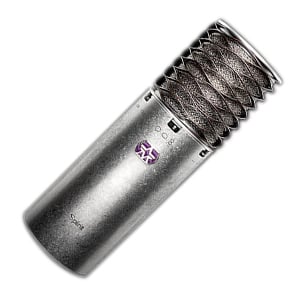
| Design: |  |
| Features: |  |
| Performance: |  |
| Value: |  |
In a mic market full of pretty standard designs, the Spirit from Aston Microphones is a breath of fresh air, with a raw, rugged look that attracts a lot of attention. With a metallic case and rustic head, you could be mistaken for thinking it was a custom boutique mic!
The tech and specs crammed into it are equally impressive, with top-tier components, all of which optimized to deliver incredible performance.
It offers a lot of maneuvering space when recording both vocals and a wide range of instruments. Be sure to read more on the Aston Microphones Spirit in the full review.
MXL V67i Tube

| Design: |  |
| Features: |  |
| Performance: |  |
| Value: |  |
There’s a reoccurring theme with higher-end mics – they look awesome. If the first two on our list weren’t enough to get the blood flowing, the V67i Tube from MXL should be!
With a regal forest green and gold color scheme, this mic looks like a premium model, and feels just as well-built. However, despite the gorgeous looks, its USP is its ability to change from a warm to bright sound profile at the flick of a switch.
As we highlight in the complete MXL V67i Tube review, this dual-diaphragm tube mic offers incredible versatility for both vocals and instrument recording.
Sennheiser MK4
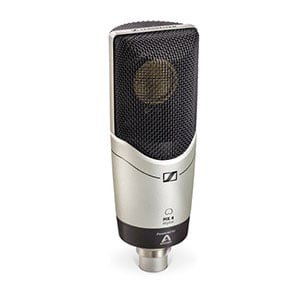
| Design: |  |
| Features: |  |
| Performance: |  |
| Value: |  |
Another new addition to this chart, the midrange Sennheiser certainly deserves its place! However, unlike some of the higher-end models on our list, this condenser doesn’t sport breathtaking looks, neither does it boast endless features.
What it does offer is a solid, no-frills mic with a smooth, well-balanced sound that’s perfect for vocal recording. With a high max SPL, it is also an excellent choice for recording instruments.
Features such as an internal shock mount to reduce the mic’s self-noise are very useful, while the build quality is spectacular. Check out the full review of the Sennheiser MK4 for all the details.
Shure SM-27
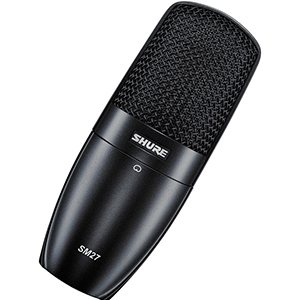
| Design: |  |
| Features: |  |
| Performance: |  |
| Value: |  |
While Shure’s bread and butter are dynamic handheld microphones, this respected brand has a good collection of reliable and capable studio condenser mics worth looking at too.
The SM27 features a chunky minimalist design with a low-mass large Mylar diaphragm, three-layer mesh cover and built-in pop filter. It also comes with a few accessories that add to the feeling of overall value.
For the midrange price, it offers a very refined performance. Due to its transparency in tone, the SM27 is an awesome general-purpose condenser for recording both vocals and instruments. For more on this cool mic, check out our extensive Shure SM27 review!
AKG P420
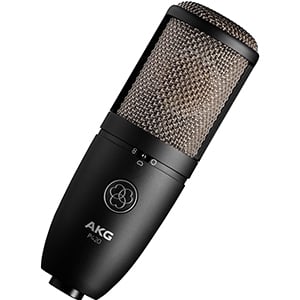
| Design: |  |
| Features: |  |
| Performance: |  |
| Value: |  |
Despite their colorful selection of microphones, AKG’s P420 dual-diaphragm side-address condenser mic is by far one of the best models in their extensive catalog.
Sitting comfortably in the affordable segment of the market, the P420 boasts a simple but solid design, good features and a surprisingly effective performance.
As we elaborate on in the full review of the AKG P420, it comes with three selectable polar patterns, an attenuation pad and a low-cut filter, which are features usually reserved for more expensive mics. Considering its low price, the P420 shows excellent value for money.
Audio-Technica AT2035
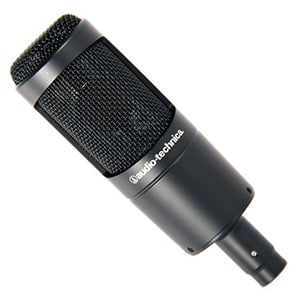
| Design: |  |
| Features: |  |
| Performance: |  |
| Value: |  |
Audio-Technica is one of the patron saints of the budget market for a good reason. Namely, their gear usually offers great value for money. This certainly applies to their condenser microphones and is apparent in the excellent AT2035.
There are no flashy features or designs here, as the guys at Audio-Technica put their effort straight into delivering a solid core performance. Yet it still features a reliable build, large diaphragm and a few handy switches.
Ultimately, finding a decent budget condenser is made easy with Audio-Technica around – as we highlight in the main review of the AT2035.
Behringer B-1
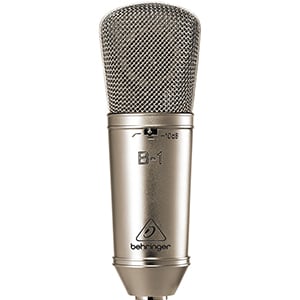
| Design: |  |
| Features: |  |
| Performance: |  |
| Value: |  |
With the B-1, Behringer offers a very strong large-diaphragm condenser microphone at a head-scratchingly low price.
This mic features a relatively simple design with a cool vintage finish and a very reliable build quality. Considering the low price, the performance on offer is fairly refined, offering a great frequency response range and max SPL.
On top of that, it packs some solid features, including built-in attenuation and a low-cut filter, as well as coming with its own suspension mount and padded aluminum case. We delve deeper into the Behringer B-1 in the full review.
Audio-Technica AT2020
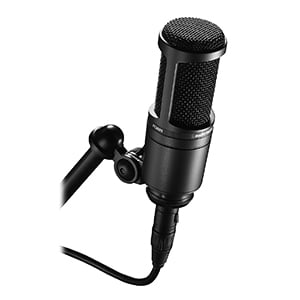
| Design: |  |
| Features: |  |
| Performance: |  |
| Value: |  |
Earlier on this page we highlighted the AT2035, but now – at under $100 – we come to the super-affordable and much-loved AT2020 from Audio-Technica.
This very popular large-diaphragm condenser features a basic but stylish design and a surprisingly impressive build for so few beans. In fact, there are very few compromises here, as we explain in the full AT2020 review.
It’s an excellent general-purpose studio microphone that is great for recording vocals, while it can take on a variety of acoustic instruments too. Overall, it’s a simple mic, but one that is mightily impressive.
MXL 770

| Design: |  |
| Features: |  |
| Performance: |  |
| Value: |  |
The 770 from MXL is another budget general-purpose condenser microphone that is perfect for beginners, although it’s just as popular with advanced users.
This is because this versatile small-diaphragm mic offers a natural, organic replication of vocals with good warmth, while recording acoustic instruments is no problem with a generous max SPL of 137dB.
Throw in a robust all-metal build, a low-frequency roll-off switch, a 10dB attenuation pad and some solid accessories including a sturdy plastic case, and this mic proves great value. For more on the MXL 770 check out the full review.
What is a Condenser Microphone?
Unlike dynamic mics – which are widely seen in live music scenarios as well as broadcasting (from radio to podcasts) – condenser mics are undoubtedly the best style of microphone for recording music in a studio setting.
The reason being that condensers are more sensitive, offer a greater range, and are generally capable of capturing even the smallest subtleties of the human voice and acoustic instruments. For this reason, they are a mainstay in studios of all sizes around the world.
At times, you will see them being used for live performances too, although they tend to be too complex and too fragile to be practical enough (unless they are purpose-built for the stage – we feature reviews of several of these mics across the site, including the Audio-Technica AE5400).
So, what exactly defines a condenser mic?
Firstly, the core of the microphone is a diaphragm – a very thin and featherlight electrically-conductive membrane that sits very close to a solid metal plate (called the backplate). When you speak into the microphone, the membrane captures the sound in the form of vibrations, which are then translated into an electrical signal.
However, as this signal has very little current, it must first be boosted via an impedance converter. As a result of this, you need to feed the microphone with outside power. This is why most condenser microphones require ‘phantom power’ in order to work. In short, condenser mics offer a detailed sound, but are fairly complicated and depend on external power to work.
What Types of Condenser Mics are There?
We have touched upon the fact that a diaphragm will capture and translate sound into an electrical signal, while changing the size of the membrane will change the resulting output. With this in mind, there two types of condenser microphones you can buy, both with different benefits and purposes: small diaphragm and large diaphragm mics.
Small Diaphragm Condensers
With a smaller membrane (usually less than half an inch in diameter), the main benefit of a small-diaphragm condenser is that it gives you a natural replication of what is being played. These versatile mics feature a high dynamic range and wide frequency response, and capture the purest tone. For these reasons, a small diaphragm mic is something that would work well in recording a choir, orchestra or several acoustic instruments being played simultaneously. They are very popular for recording classical music and have a great bass response.
Large Diaphragm Condensers
With a typical diameter of around 1” or more, large-diaphragm mics were the first to appear and are still around for good reason. The main benefit of a larger diaphragm is the way that they react to the human voice and various musical instruments. Where a smaller diaphragm is more clinical, a larger one tends to add warmth. While this used to be considered a flaw, these days people are seeking out that warmth wherever possible – essentially it makes you sound better! They may not have the flatness or neutrality that a small diaphragm mic can offer, but their warmth is very desirable to some engineers, especially those recording vocals.
Things to Consider When Choosing a Condenser Mic
There is one trait that all condensers share – and that is that they are all different! Even if every model had the same specs, each particular mic would still be unique in some way. You often hear vocalists talking about condensers that work well with their voice, and those that don’t – a strange phenomenon, but one that is true. Unfortunately, you won’t really know whether a mic will be compatible with the profile of your voice until you try it. Something to keep in mind.
So, what should you consider when buying a condenser mic? Let’s take a quick look at some of the things a good condenser mic will feature:
Frequency Response Range
Aside from whether it has a small or large diaphragm, the first thing you should consider is the frequency response range of a given model. By this, we mean the microphone’s ability to capture sound ranging from low to high frequencies. Fortunately, most of the models available today cover a similar range of frequencies (around 20Hz to 20kHz). Still, some mics are a bit narrow in their frequency response, so be aware of this if you are aiming to record instruments.
Maximum Sound Pressure Level
The Sound Pressure Level (SPL) is a very useful metric that can tell you how well a microphone will react to various sources of sound. While it’s a complicated topic, in short, the SPL value indicates how much volume a microphone can take before the sound starts to distort. If you are only recording vocals, this is something you will rarely have to worry about. However, if you are recording acoustic instruments, drums or more aggressive sounds (including electric guitars or brass instruments), it is important that your microphone has a higher SPL rating or you risk having poor results. Anywhere from around 130dB upwards is usually sufficient.
Polar Patterns
You are unlikely to buy a condenser mic based solely on the polar pattern alone, yet it’s worth knowing what one is and why it is important.
The polar pattern basically describes the sensitivity of sound each part of the mic offers. Look at an omnidirectional mic – holding it upright, you could speak into the top, side, back, left or right part of the head, knowing that wherever you are the sound will be picked up evenly.
The most common pattern, found on all mics, is a cardioid pattern – where the front of the mic is more sensitive to sound than the back. From there, the angle of attack increases as you work through other patterns, such as supercardioid, bidirectional, hypercardioid and more.
For more on this complicated topic, this helpful article on polar patterns from Shure will put you on the right track.
Features and Accessories
The features you will see on a condenser mic will vary from brand to brand and depend largely on the price range the mic is in. However, you may run across things such as built-in attenuation and various filters across all categories.
Attenuation is very handy if you need to record louder instruments, as it essentially increases the SPL-handling capability of a microphone. Filters offer some versatility by cutting off specific frequencies, mostly those from the low-end of the range (which can help trim some boomy tones, for example).
As for accessories, most microphones, even those in the budget range, will offer something in the way of a carry case. Even if you don’t plan to travel around with it, these can be very useful to store and protect your mic when not in use. A shock mount – which helps protect and isolate microphones from mechanically transmitted noise – are typical included at most price points, although not a deal-breaker.
The Final Word
Having read this article, you will now probably agree that condenser microphones are one of the most important pieces of gear in any recording studio. The warmth and beauty they offer when capturing sound is something you simply won’t be able to achieve with a standard dynamic mic.
The microphone models we have highlighted above are some of the best condensers on the market today. Be sure to take a look at the dedicated pages of the mics in your budget, whether affordable condenser mics or higher-end models.
Take your time and good luck with your search for the perfect condenser mic!
If you need more help with setting up your studio, check out the related buying guides for recording gear:
Studio Monitors
Studio Headphones
Audio Interfaces
Microphones: Dynamic|USB
Laptops For Music Production
MIDI Controllers
DAW Software



Reader Interactions